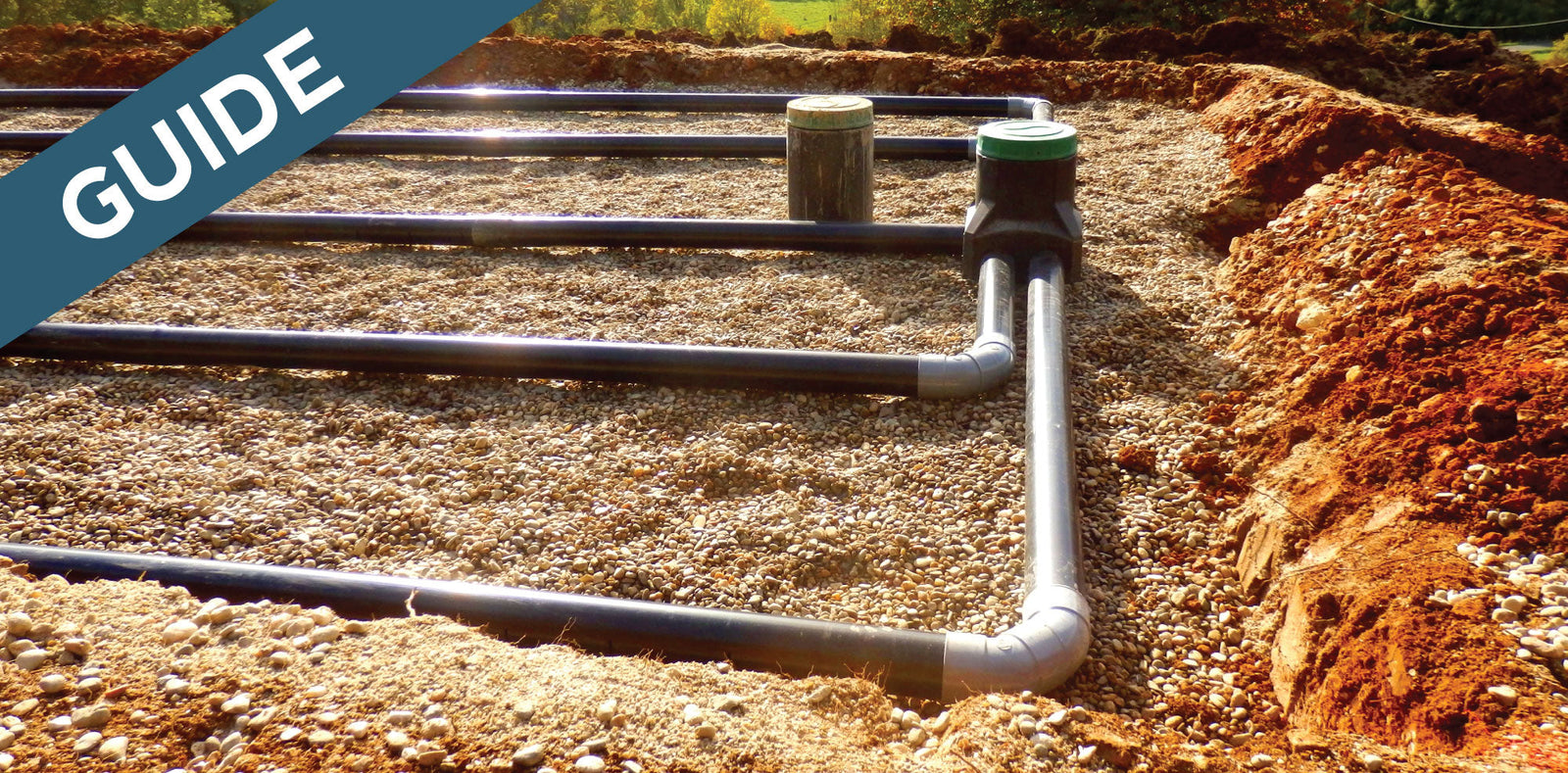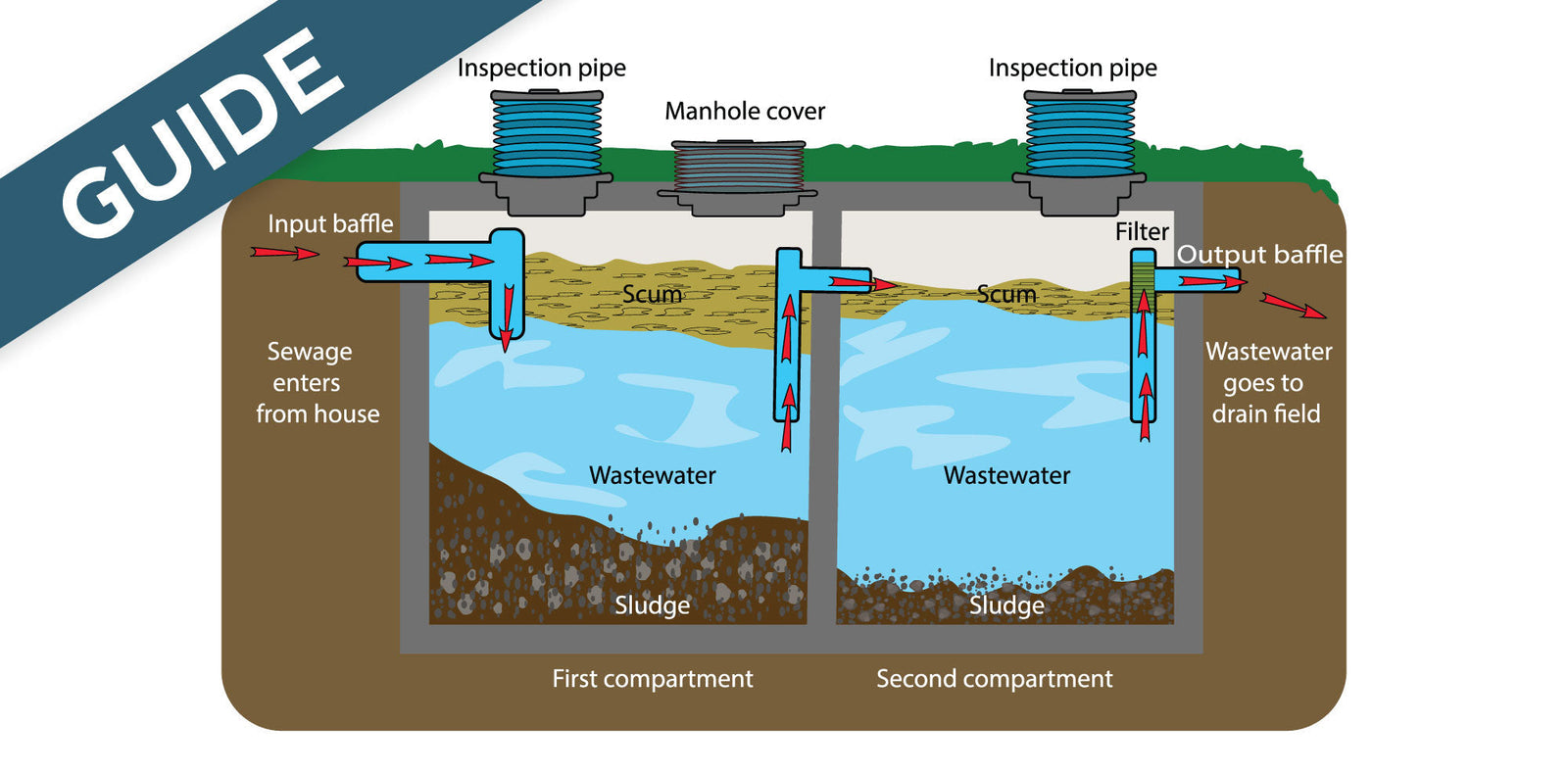Key Points
- A septic system is a contained wastewater treatment system for your home, typically consisting of a septic tank, a lateral line system, and a leach field.
- A septic system’s main job is to break down wastewater. It uses beneficial bacteria to separate wastewater into scum and sludge, then drains out excess water into the septic field.
- The lateral line system, typically made of PVC pipes, helps to safely drain and disperse liquid wastewater into the ground.
- Biomat, a naturally occurring type of bacteria, builds up in the leach field and helps to remove any further impurities from the wastewater, eliminating environmental impacts and safely recycling the wastewater.
- Although septic tank + field is the most common type of septic system, there are other kinds of systems, including septic tank + seepage pit, septic tank + lagoon, and aerobic septic systems.
- It is important to properly care for your septic system, which includes regularly treating your septic system, changing some of your bathroom and kitchen habits to help protect your septic system, and periodically pumping out your septic system.
It's fair to say that septic systems are essential to our way of life, but have you ever wondered what a septic system actually is or how it works? Whether you are completely new to septic systems or already have some experience, learning how a septic system works will help you to successfully care for it.
What Is A Septic System?
At the most basic level, a septic system is a digestive system (sort of like the digestive system in your body, but on a larger scale). More specifically, a septic system is a special kind of wastewater system for your home. It is completely contained. In other words, it doesn’t connect to a larger wastewater system, like your city’s sewer system. Though it might at first seem complicated, a septic system is actually rather simple in its design. Normally, a conventional septic system consists of a septic tank – typically made of concrete (though fiberglass and plastic tanks are also likely), a lateral line system, and a leach field.
How A Septic System Functions
A septic system’s main job is to break down waste. When you flush your toilet, use your shower or sinks, or do your laundry, the wastewater flows through your plumbing, into a main drainage pipe, and out into your septic tank (usually buried underground). This septic tank generally has an average capacity of about 1000 to 1500 gallons, but they can certainly be larger or smaller.
Next, the waste is broken down into “scum” and “sludge” by helpful bacteria that live in your septic tank. The “scum” is made up of fats, oils, and greases, and it normally floats to the surface of the waste in your septic tank, creating a scummy layer on the top. The “sludge,” as its name implies, is much denser. It is generally made up of proteins, carbohydrates, and undigested solids. Since its denser and heavier, the sludge usually sinks to the bottom of your septic tank.
With the scum and sludge removed from the wastewater, the septic system’s next task is to allow the remaining water to flow out of your septic tank and into the septic field. Think of the septic field as simply an extension of your septic tank. Except, instead of dealing with solid waste, its job is to safely drain and disperse liquid wastewater into the ground.
The septic field (also called the leach field, drain field, or leach drain) is where the lateral line system is found. A septic field is normally pretty easy to find. It’s a wide-open space (often in your backyard) with no surrounding trees or bushes, since the roots will block the lateral line system. The lateral lines themselves are long sections of pipe (normally PVC pipe) that extend out into the leach field, where they are surrounded by gravel and absorbent soil. There is normally a layer of gravel between the pipes and the soil below. These pipes have tiny holes or perforations in them that allow wastewater to “leach” or filter out into the septic field.
As this occurs, a material called biomat builds up around the holes in the pipes. Biomat is essentially a bacterial layer of slime that helps to further break down wastewater. As wastewater passes through the lateral line system, the biomat removes impurities in the wastewater such as harmful coliform bacteria, which is often found in the intestines of warm blooded animals. Biomat removes these sorts of contaminants, eliminating any negative environmental impacts. Afterwards, the now entirely clean wastewater flows safely back into the ground water and is eventually recycled.
Different types of septic systems.
Although a conventional septic system (as described above) is most common, there are several other types of septic systems. These include:
- Septic Tank + Field. This sort of system has been described at length in this article, and it is the most common type of septic system.
- Septic Tank + Seepage Pit. In this system, waste is still collected in large septic tank, but after the waste is separated into scum and sludge, the wastewater flows out into a seepage pit, which disperses the liquid into the ground water. Although similar to a septic field, a seepage pit takes up less space, and it allows wastewater to seep much deeper into the ground.
- Septic Tank + Lagoon. In a septic tank + lagoon system, waste is collected in a large septic tank, where it is broken down into scum, sludge, and liquid just like the other systems, but when the liquid exits the septic tank, it enters a small body of water.
- Aerobic System. An aerobic septic system pumps oxygen into the septic holding tank. This increases the activity of aerobic bacteria, which thrive on high levels of oxygen. In a typical septic tank, most of the bacteria is anaerobic (this type of bacteria thrives in low-oxygen environments). Since aerobic bacteria generally breaks down waste better than anaerobic bacteria, aerobic septic systems are generally cleaner than those that use anaerobic bacteria. The idea with these systems is that the septic field will do less work to filter the wastewater, which theoretically decreases maintenance. To learn more about aerobic septic systems, click here.
There are many different variations on standard septic systems. To learn more, click here.
Properly Caring For A Septic System
Regardless of the type of septic system you might have, it is important to properly care for your septic system in order for it to function smoothly and last a long time. The main considerations to take into account when caring for your septic system is that you regularly treat your system with a high-quality septic treatment (we recommend Unique Septic System Digester), you occasionally perform a deep clean on your septic field to clean out any potentially clogged laterals (we recommend using Unique Septic Field Rejuvenator) and you must pump out your septic system periodically. Eventually, your septic tank will fill up with waste, and the waste will need to be physically removed. A pumping service can help you to pump out the built-up waste
What Happens If I Don’t Pump Out My Septic System?
If a septic system is not regularly pumped when full of waste, bad odors and waste itself will begin backing up into your home. Also, you may encounter standing wastewater in your septic field (which is never a good thing). As you can see, it’s absolutely critical that you keep track of the level in your septic tank, either by inspecting it yourself or having a professional septic tank service check it.
How Do I Treat My Septic System and Is It Necessary?
Regularly treating your septic system can help to avoid backups and keep the system working correctly. We recommend using Unique Septic System Digester. Learn more about using this product here. Backups, clogs, and bad odors can occur if a septic system is not regularly treated.
Rules To Follow To Prevent Septic System Failure:
There are a number of habits that you will need to introduce into your normal routine if you live on a septic system. These are very important because failure to implement these simple changes can result in major problems with your septic system that can be expensive to fix and disgusting or embarrassing.
We have written an entire article on these habits. Learn more about what things you need to do to prevent septic problems here.
Please feel free to reach out if you have any further questions or concerns! We’re always here to help: support@uniquemm.com.





